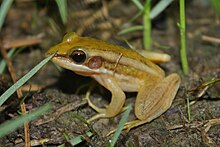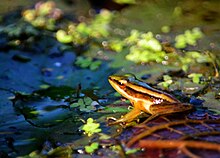Thecommon green frog(Hylarana erythraea) is afrogspecies of in the true frogfamilyRanidae;[2]some sources still use the old nameRana erythraea.It lives inSoutheast Asiaand is also known asgreen paddy frog,red-eared frogorleaf frog.[1]The last name, however, commonly refers to theNeotropicaltree frogs which make up thesubfamilyPhyllomedusinae.These are not closely related toH. erythraea,belonging to familyHylidaeinstead.
| Common green frog | |
|---|---|

| |

| |
| FromErnst Haeckel'sKunstformen der Natur | |
| Scientific classification | |
| Domain: | Eukaryota |
| Kingdom: | Animalia |
| Phylum: | Chordata |
| Class: | Amphibia |
| Order: | Anura |
| Family: | Ranidae |
| Genus: | Hylarana |
| Species: | H. erythraea
|
| Binomial name | |
| Hylarana erythraea (Schlegel,1837)
| |
| Synonyms | |
|
Several, seetext | |

Taxonomy and systematics
editLong placed inRana,it is only as closely related to this genus as is e.g.Amolops.Consequently, the genusHylarana,of which the common green frog is thetype species,warrants re-establishment.Hylaranaseems to form acladetogether with the similarly revalidated generaPulchranaandSylvirana,and presumably alsoHydrophylaxas well as some species presently placed inPelophylax(e.g.Kokarit Frog,"P." lateralis).[3]
This frog has confused researchers for a long time, as it resemblestree frogsinhabitus.It was initially placed in the tree frog genusHyla.Thejunior synonymsof the common green frog are:
- Hyla erythraeaSchlegel, 1837
- Hylorana erythraea(lapsus)
- Limnodytes erythraeus(Schlegel, 1837)
- Polypedates erythraea(Schlegel, 1837)
- Rana erythraea(Schlegel, 1837)
Description
editMaleHylarana erythraeagrow to a snout–vent length of 30–45 mm (1.2–1.8 in) and females to 50–75 mm (2.0–3.0 in).Tadpolesare up to 36 mm (1.4 in) in length. They have smooth skin that is bright green above and on sides.Tympanumis distinct.[4]
Distribution and ecology
editH. erythraeaoccurs inBrunei,Cambodia,Indonesia,Laos,Malaysia,Myanmar,Singapore,Thailand,andVietnam.It has been observed as high as 1200 meters above sea level. Introduced populations are found onSulawesiand thePhilippines.The similar frogs from northeasternIndiaand adjacent regions, formerly included here, are now separated asHylarana tytleri.[2][1]
Its naturalhabitatsare subtropical or tropical moist lowlandforests,subtropical or tropical moistmontane forests,freshwaterlakes,intermittent freshwater lakes, freshwatermarshes,intermittent freshwater marshes, rural gardens, heavily degraded former forest, irrigated land, seasonally flooded agricultural land, and introduced vegetation.[1]
Footnotes
edit- ^abcdIUCN SSC Amphibian Specialist Group (2014)."Hylarana erythraea".IUCN Red List of Threatened Species.2014:e.T58593A64131003.doi:10.2305/IUCN.UK.2014-3.RLTS.T58593A64131003.en.Retrieved13 November2021.
- ^abFrost, Darrel R. (2014)."Hylarana erythraea(Schlegel, 1837) ".Amphibian Species of the World: an Online Reference. Version 6.0.American Museum of Natural History.Retrieved31 July2014.
- ^Stuart (2008), van Dijket al.(2011)
- ^"Hylarana erythraea".Amphibians and Reptiles of Peninsular Malaysia.Retrieved31 July2014.
References
edit- IUCN SSC Amphibian Specialist Group (2014)."Hylarana erythraea".IUCN Red List of Threatened Species.2014:e.T58593A64131003.doi:10.2305/IUCN.UK.2014-3.RLTS.T58593A64131003.en.Retrieved13 November2021.
- Stuart, Bryan L.(2008): The phylogenetic problem ofHuia(Amphibia: Ranidae).Mol. Phylogenet. Evol.46(1): 49-60.doi:10.1016/j.ympev.2007.09.016PDF fulltext
